2023 NISSAN ARMADA ECU
[x] Cancel search: ECUPage 18 of 604

0-10Illustrated table of contents
Red lightNamePage
Automatic Transmission
(AT) oil temperature warn-
ing light 2-12
Automatic Transmission
(AT) park warning light
2-12
Brake warning light
2-12
Charge warning light2-13
Engine oil pressure warning
light2-13
Master warning light
2-14
Seat belt warning light
2-14
Security indicator light2-14
Supplemental air bag
warning light2-14Yellow
light Name
Page
Anti-lock Braking System
(ABS) warning light 2-15
Automatic Emergency
Braking (AEB) system
warning light2-15
Automatic Transmission
(AT) check warning light
2-15
Check suspension indicator
light
2-15
Front passenger air bag
status light
2-15
Four-Wheel Drive (4WD)
warning light (4WD models)2-16
Low tire pressure warning
light
2-16
Malfunction Indicator Light
(MIL)2-18
Master warning light
2-18
Rear Automatic Braking
(RAB) system warning light2-18
Vehicle Dynamic Control
(VDC) off indicator light
2-19
Vehicle Dynamic Control
(VDC) warning light2-19Other
light Name
Page
Exterior light indicator
2-19
Front fog light indicator
light (if so equipped)2-19
High beam assist indicator
light2-19
High beam indicator light
2-19
TOW mode indicator light2-19
Turn signal/hazard indica-
tor lights2-19
WARNING AND INDICATOR LIGHTS
Page 23 of 604
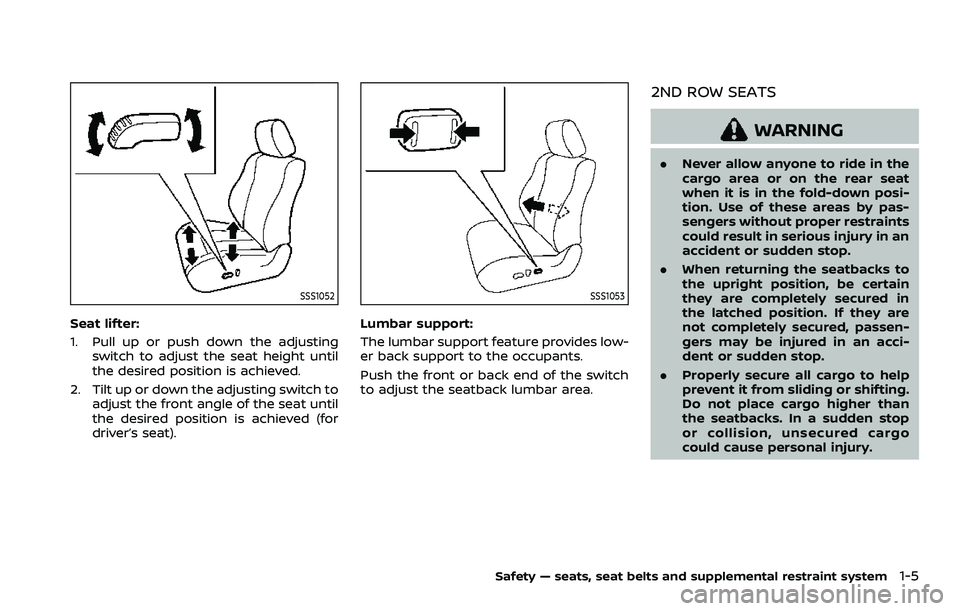
SSS1052
Seat lifter:
1. Pull up or push down the adjustingswitch to adjust the seat height until
the desired position is achieved.
2. Tilt up or down the adjusting switch to adjust the front angle of the seat until
the desired position is achieved (for
driver’s seat).
SSS1053
Lumbar support:
The lumbar support feature provides low-
er back support to the occupants.
Push the front or back end of the switch
to adjust the seatback lumbar area.
2ND ROW SEATS
WARNING
.Never allow anyone to ride in the
cargo area or on the rear seat
when it is in the fold-down posi-
tion. Use of these areas by pas-
sengers without proper restraints
could result in serious injury in an
accident or sudden stop.
. When returning the seatbacks to
the upright position, be certain
they are completely secured in
the latched position. If they are
not completely secured, passen-
gers may be injured in an acci-
dent or sudden stop.
. Properly secure all cargo to help
prevent it from sliding or shifting.
Do not place cargo higher than
the seatbacks. In a sudden stop
or collision, unsecured cargo
could cause personal injury.
Safety — seats, seat belts and supplemental restraint system1-5
Page 24 of 604
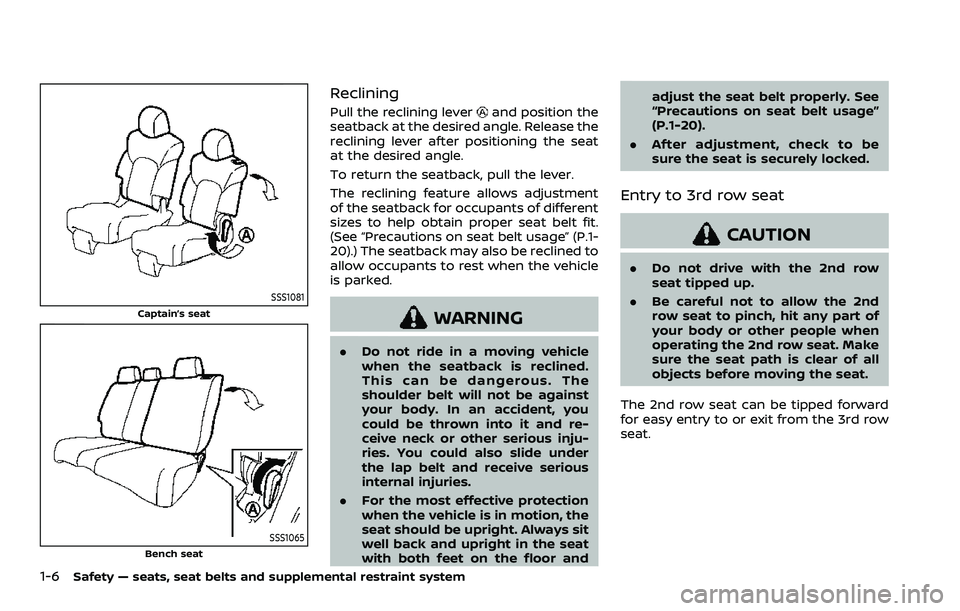
1-6Safety — seats, seat belts and supplemental restraint system
SSS1081
Captain’s seat
SSS1065Bench seat
Reclining
Pull the reclining leverand position the
seatback at the desired angle. Release the
reclining lever after positioning the seat
at the desired angle.
To return the seatback, pull the lever.
The reclining feature allows adjustment
of the seatback for occupants of different
sizes to help obtain proper seat belt fit.
(See “Precautions on seat belt usage” (P.1-
20).) The seatback may also be reclined to
allow occupants to rest when the vehicle
is parked.
WARNING
. Do not ride in a moving vehicle
when the seatback is reclined.
This can be dangerous. The
shoulder belt will not be against
your body. In an accident, you
could be thrown into it and re-
ceive neck or other serious inju-
ries. You could also slide under
the lap belt and receive serious
internal injuries.
. For the most effective protection
when the vehicle is in motion, the
seat should be upright. Always sit
well back and upright in the seat
with both feet on the floor and adjust the seat belt properly. See
“Precautions on seat belt usage”
(P.1-20).
. After adjustment, check to be
sure the seat is securely locked.
Entry to 3rd row seat
CAUTION
.Do not drive with the 2nd row
seat tipped up.
. Be careful not to allow the 2nd
row seat to pinch, hit any part of
your body or other people when
operating the 2nd row seat. Make
sure the seat path is clear of all
objects before moving the seat.
The 2nd row seat can be tipped forward
for easy entry to or exit from the 3rd row
seat.
Page 26 of 604
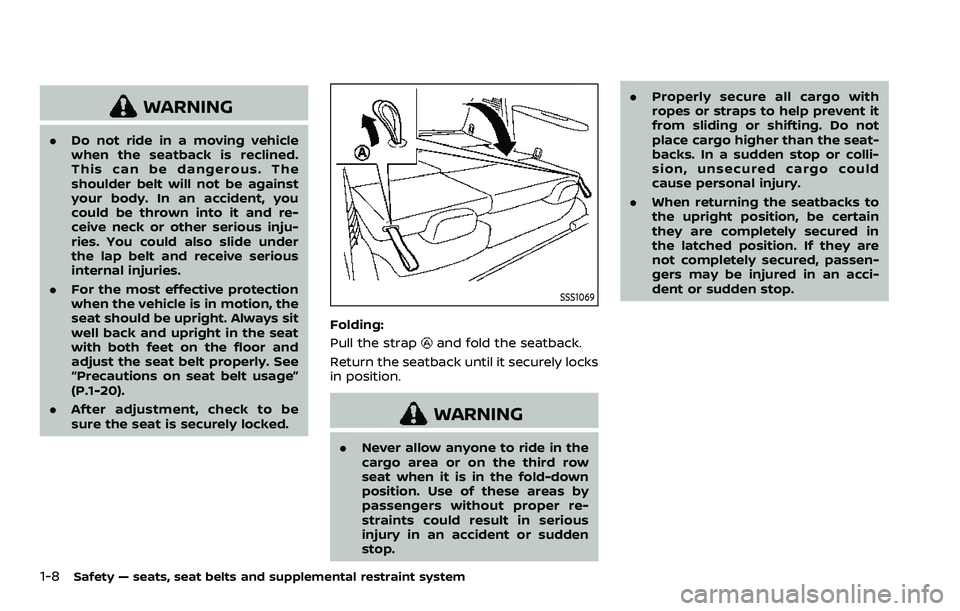
1-8Safety — seats, seat belts and supplemental restraint system
WARNING
.Do not ride in a moving vehicle
when the seatback is reclined.
This can be dangerous. The
shoulder belt will not be against
your body. In an accident, you
could be thrown into it and re-
ceive neck or other serious inju-
ries. You could also slide under
the lap belt and receive serious
internal injuries.
. For the most effective protection
when the vehicle is in motion, the
seat should be upright. Always sit
well back and upright in the seat
with both feet on the floor and
adjust the seat belt properly. See
“Precautions on seat belt usage”
(P.1-20).
. After adjustment, check to be
sure the seat is securely locked.
SSS1069
Folding:
Pull the strap
and fold the seatback.
Return the seatback until it securely locks
in position.
WARNING
. Never allow anyone to ride in the
cargo area or on the third row
seat when it is in the fold-down
position. Use of these areas by
passengers without proper re-
straints could result in serious
injury in an accident or sudden
stop. .
Properly secure all cargo with
ropes or straps to help prevent it
from sliding or shifting. Do not
place cargo higher than the seat-
backs. In a sudden stop or colli-
sion, unsecured cargo could
cause personal injury.
. When returning the seatbacks to
the upright position, be certain
they are completely secured in
the latched position. If they are
not completely secured, passen-
gers may be injured in an acci-
dent or sudden stop.
Page 27 of 604
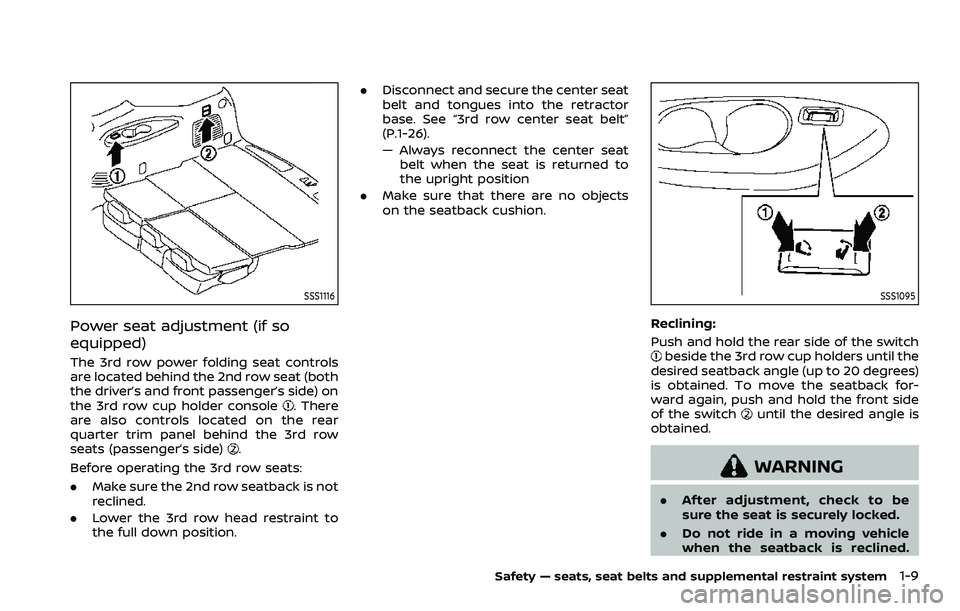
SSS1116
Power seat adjustment (if so
equipped)
The 3rd row power folding seat controls
are located behind the 2nd row seat (both
the driver’s and front passenger’s side) on
the 3rd row cup holder console
. There
are also controls located on the rear
quarter trim panel behind the 3rd row
seats (passenger’s side)
.
Before operating the 3rd row seats:
. Make sure the 2nd row seatback is not
reclined.
. Lower the 3rd row head restraint to
the full down position. .
Disconnect and secure the center seat
belt and tongues into the retractor
base. See “3rd row center seat belt”
(P.1-26).
— Always reconnect the center seat
belt when the seat is returned to
the upright position
. Make sure that there are no objects
on the seatback cushion.
SSS1095
Reclining:
Push and hold the rear side of the switch
beside the 3rd row cup holders until the
desired seatback angle (up to 20 degrees)
is obtained. To move the seatback for-
ward again, push and hold the front side
of the switch
until the desired angle is
obtained.
WARNING
. After adjustment, check to be
sure the seat is securely locked.
. Do not ride in a moving vehicle
when the seatback is reclined.
Safety — seats, seat belts and supplemental restraint system1-9
Page 29 of 604
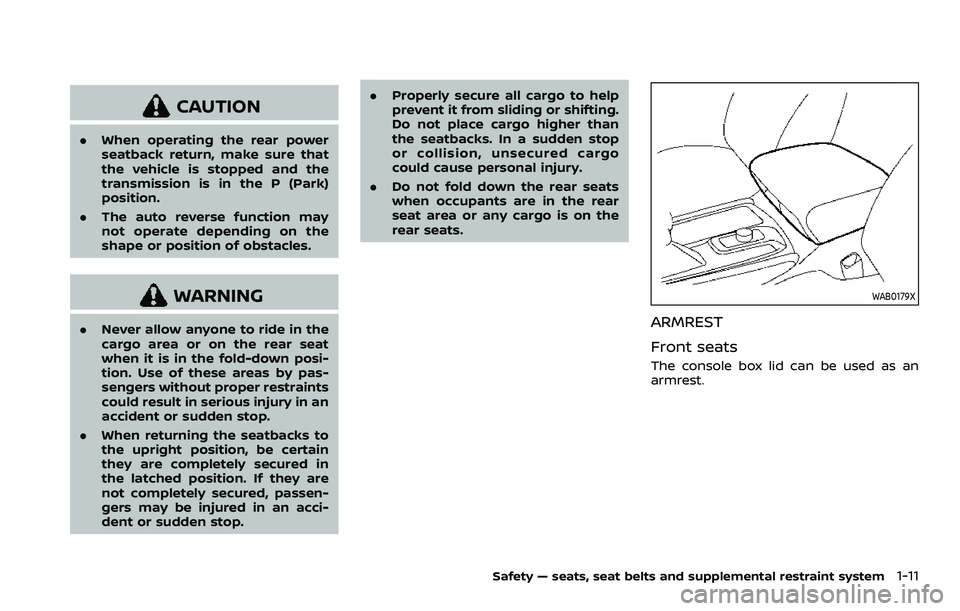
CAUTION
.When operating the rear power
seatback return, make sure that
the vehicle is stopped and the
transmission is in the P (Park)
position.
. The auto reverse function may
not operate depending on the
shape or position of obstacles.
WARNING
.Never allow anyone to ride in the
cargo area or on the rear seat
when it is in the fold-down posi-
tion. Use of these areas by pas-
sengers without proper restraints
could result in serious injury in an
accident or sudden stop.
. When returning the seatbacks to
the upright position, be certain
they are completely secured in
the latched position. If they are
not completely secured, passen-
gers may be injured in an acci-
dent or sudden stop. .
Properly secure all cargo to help
prevent it from sliding or shifting.
Do not place cargo higher than
the seatbacks. In a sudden stop
or collision, unsecured cargo
could cause personal injury.
. Do not fold down the rear seats
when occupants are in the rear
seat area or any cargo is on the
rear seats.
WAB0179X
ARMREST
Front seats
The console box lid can be used as an
armrest.
Safety — seats, seat belts and supplemental restraint system1-11
Page 30 of 604
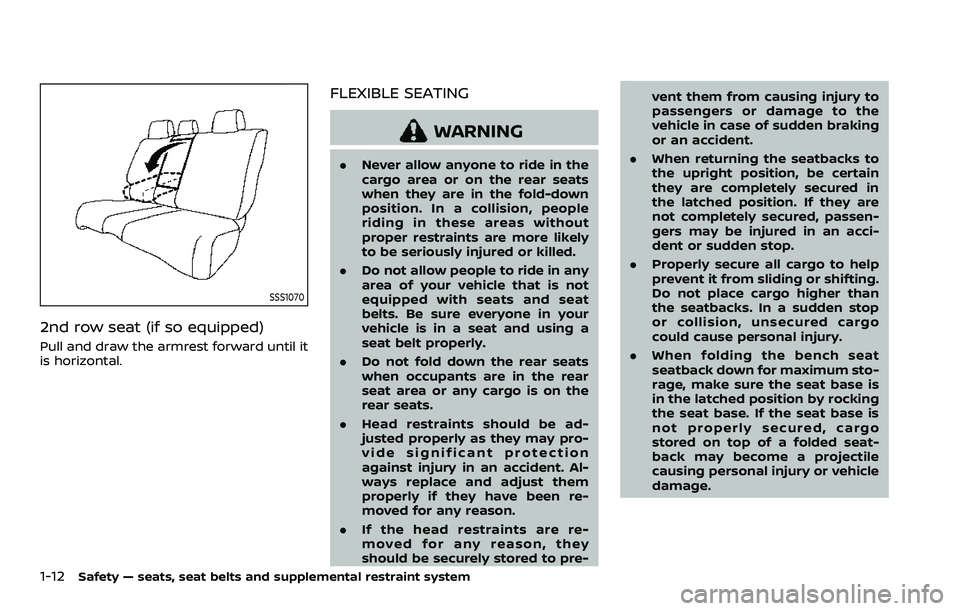
1-12Safety — seats, seat belts and supplemental restraint system
SSS1070
2nd row seat (if so equipped)
Pull and draw the armrest forward until it
is horizontal.
FLEXIBLE SEATING
WARNING
.Never allow anyone to ride in the
cargo area or on the rear seats
when they are in the fold-down
position. In a collision, people
riding in these areas without
proper restraints are more likely
to be seriously injured or killed.
. Do not allow people to ride in any
area of your vehicle that is not
equipped with seats and seat
belts. Be sure everyone in your
vehicle is in a seat and using a
seat belt properly.
. Do not fold down the rear seats
when occupants are in the rear
seat area or any cargo is on the
rear seats.
. Head restraints should be ad-
justed properly as they may pro-
vide significant protection
against injury in an accident. Al-
ways replace and adjust them
properly if they have been re-
moved for any reason.
. If the head restraints are re-
moved for any reason, they
should be securely stored to pre- vent them from causing injury to
passengers or damage to the
vehicle in case of sudden braking
or an accident.
. When returning the seatbacks to
the upright position, be certain
they are completely secured in
the latched position. If they are
not completely secured, passen-
gers may be injured in an acci-
dent or sudden stop.
. Properly secure all cargo to help
prevent it from sliding or shifting.
Do not place cargo higher than
the seatbacks. In a sudden stop
or collision, unsecured cargo
could cause personal injury.
. When folding the bench seat
seatback down for maximum sto-
rage, make sure the seat base is
in the latched position by rocking
the seat base. If the seat base is
not properly secured, cargo
stored on top of a folded seat-
back may become a projectile
causing personal injury or vehicle
damage.
Page 33 of 604
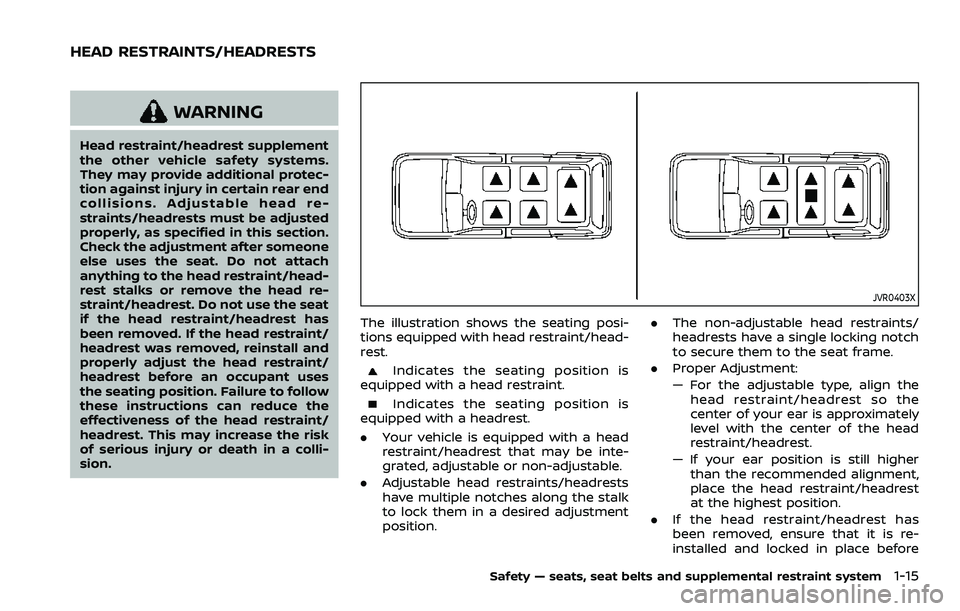
WARNING
Head restraint/headrest supplement
the other vehicle safety systems.
They may provide additional protec-
tion against injury in certain rear end
collisions. Adjustable head re-
straints/headrests must be adjusted
properly, as specified in this section.
Check the adjustment after someone
else uses the seat. Do not attach
anything to the head restraint/head-
rest stalks or remove the head re-
straint/headrest. Do not use the seat
if the head restraint/headrest has
been removed. If the head restraint/
headrest was removed, reinstall and
properly adjust the head restraint/
headrest before an occupant uses
the seating position. Failure to follow
these instructions can reduce the
effectiveness of the head restraint/
headrest. This may increase the risk
of serious injury or death in a colli-
sion.
JVR0403X
The illustration shows the seating posi-
tions equipped with head restraint/head-
rest.
Indicates the seating position is
equipped with a head restraint.
Indicates the seating position is
equipped with a headrest.
. Your vehicle is equipped with a head
restraint/headrest that may be inte-
grated, adjustable or non-adjustable.
. Adjustable head restraints/headrests
have multiple notches along the stalk
to lock them in a desired adjustment
position. .
The non-adjustable head restraints/
headrests have a single locking notch
to secure them to the seat frame.
. Proper Adjustment:
— For the adjustable type, align the
head restraint/headrest so the
center of your ear is approximately
level with the center of the head
restraint/headrest.
— If your ear position is still higher than the recommended alignment,
place the head restraint/headrest
at the highest position.
. If the head restraint/headrest has
been removed, ensure that it is re-
installed and locked in place before
Safety — seats, seat belts and supplemental restraint system1-15
HEAD RESTRAINTS/HEADRESTS